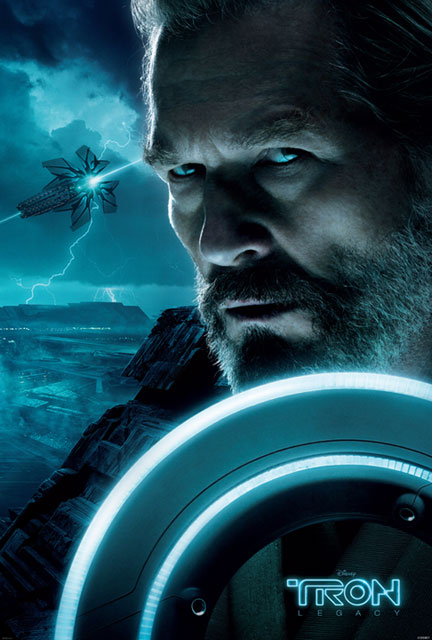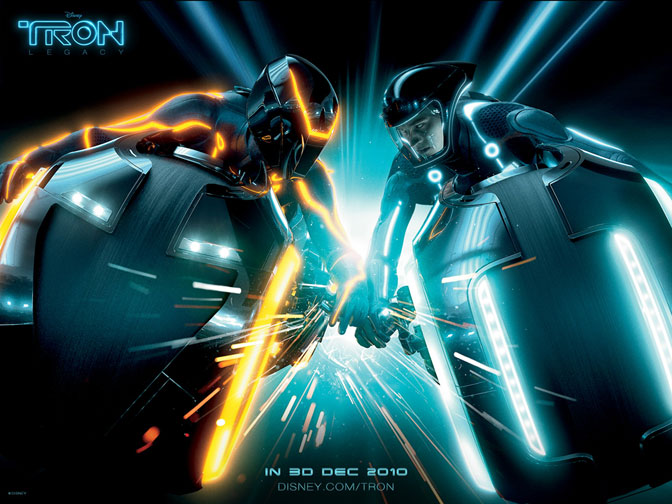For Art Center alumnus Eric Barba, things didn’t seem like they could get any better after he won an Oscar for his groundbreaking special effects work on The Curious Case of Benjamin Button. That is, until he got the gig overseeing the special effects for Tron: Legacy, opening this weekend.

Courtesy of Disney
For Benjamin Button, Barba was tasked with making Brad Pitt appear older. For Tron: Legacy, his challenge was the opposite: to make a present-day Jeff Bridges appear as he did in the 1982 original. And, it had to appear authentic. Add to that the intense pressure of a cult-status 1982 film Tron (visualized by another Art Center alum, Syd Mead, who we also spoke to this week), and Barba had his work cut out for him.
Barba has been with the SoCal-based Digital Domain visual production studio for 13 years, and like many of the top directors he collaborates with, he’s equally comfortable working in film or advertising. He started at Digital Domain as a digital artist on The Fifth Element and CG supervisor on Supernova before rising to visual effects supervisor for David Fincher’s Zodiac.
As we count down to the opening of Tron: Legacy, the Dotted Line caught up with Barba to talk about his work as visual effects supervisor on this much-anticipated movie, his work and, of course, Art Center.
Dotted Line: How was working on the new Tron film different from others you’ve worked on?
Eric Barba: This was the most difficult project I’ve ever done, for many reasons. It was by far the most challenging. The work we had done on Benjamin Button was considered the holy grail of special effects because we were aging a human face, which hadn’t been done before. The [Jeff Bridges] character Clu pushes that envelope so far, and so much faster, than we expected. We didn’t know that these sorts of effects [such as portraying a decades-younger Bridges] were even possible to do. And working in 3D was new for me, too.
Dotted Line: What are the different considerations when working in 3D?
Barba: It’s incredibly challenging technically, because we’re still in the early stages of learning how to shoot 3D from a how-the-camera-works standpoint. I like to joke that the camera we used to film this will be in a museum at some point as a relic, because if you look at it, it’s actually two cameras strapped together.
And because of this there are a lot of technical challenges and mechanical imperfections, lens imperfections and the like. You have to continuously fix things and put stuff back together. For example, when we’re trying to shoot two actors playing a disc game, if they don’t stand in the correct space on a 50-foot screen, then the shot is ruined. All the techniques we use for tracking—making sure our CG and our studio camera line up—have to be rewritten because they have to be much, much more accurate for 3D. And you have to render everything twice, so it’s twice the disk space. Then you have to have development systems to look at it and judge it. It definitely raises the bar as far as technical difficulty.
Dotted Line: How long did it take to do the special effects for the film?
Barba: Almost two and a half years. I was working on Benjamin Button, and did some work on the computer for this and handed it off. Then at Comic Con 2009 they showed the first trailer, and everyone loved it, so the film was green lit. So while I was finishing up Benjamin Button, I also had to start planning and putting the team together to attack Tron.

Eric Barba
Dotted Line: Did the fact that the original Tron has such a cult following add pressure to the job?
Barba: It was a huge artistic challenge from day one. As the first movie to use CG, Tron is the granddaddy of our industry. We asked ourselves, “How do we live up to the work of [Art Center alumnus] Syd Mead and Moebius, and what they did on Tron?” They created such a groundbreaking and visionary look. Not to mention, today’s movie audiences expect a lot more.
Dotted Line: Will this movie be a game-changer like the first?
Barba: Of course I hope so, but I’m so close to it that it’s hard to say. The Clu character was certainly the hardest thing we’ve ever done in terms of visual effects, so we’ll see. It’s not for me to make that decision—I think it’s up to the audiences to decide.
Dotted Line: What do you do in your role as visual effects supervisor?
Eric Barba: What that basically means is I work directly with the director. If he says, “I want to make this light bike, and I want to shoot it in live action, how do we do this?” then it’s my job to figure out the methodology of how to shoot it, and what should be done in CG. I hire the crew and work with my producer to budget, schedule and plan out the project. And then once we start doing the work, it’s my job to critique it and say, no, that should be brighter, or this should be darker, add more perspective and make the surface shiny. That sort of thing. I work with my team until I’m happy with it, then I show it to the director, and he’ll give me his feedback. And we go from there. I’m his collaborator on the artistic and effects end.
Dotted Line: Do you have directors that ask the impossible?
Barba: Absolutely. That was almost my entire career with [Zodiac and Benjamin Button director] David Fincher, who’s known for always pushing that envelope. There were many times when he would tell me what he wanted to do. I’d say no, no, we should shoot that. And he’d tell me no, no, we should do that in CG, which is kind of the opposite of the way I normally work with a director. He was pushing to do stuff we hadn’t really done before. And ultimately that led up to the work we did together for Benjamin Button, which we won an Academy Award for. So it turned out well in the end.
Dotted Line: How did you first hear about Art Center?
Barba: I actually learned about Art Center through a car magazine. As a teen, I was a big fan of cars, and decided that’s where I wanted to go to school. But first I attended both Pasadena City College and San Antonio College. I took an Art Center at Night course taught by Stan Kong, which really helped me get my portfolio together, setting the ball into motion.

Courtesy of Disney
Dotted Line: You were a Transportation Design major at Art Center. How did you go from Transportation Design to visual effects?
Barba: In the early ’90s, when I was at Art Center, Silicon Graphics was teaching the 3D computer program Alias. At that time, it wasn’t a mandatory requirement for Transportation Design students, but I found the program really interesting and took the class as an elective. Stanley Liu, who had created the shields for the first Batman film, was the instructor.
This program really intrigued me. I began to realize that I could use my design and art background to create things for movies. When I graduated from Art Center and started looking for car jobs, I realized that I really didn’t want to move to Detroit. Then I was offered a position designing toys at Kenner in Cleveland, but I didn’t want to move to Cleveland, either. Instead I took a job to working with Alias, teaching companies how to use the program for the film industry.
After a few weeks on the job they sent me to Universal, where Steven Spielberg and Amblin Entertainment were putting together a new television show called Seaquest. I was sent to show the team what could be done with Alias. So I did, and I immediately met James Lima, who was also a Transportation Design major from Art Center who had worked for General Motors as a car designer, and left to become an art director. Now he was in charge of the design for this television show. So of course we hit it off immediately.
Lima would hand me the sketches, and I would build them in Alias, and right off the bat they could see what I could do, and that I could design things as I went. To make a long story short, they made me an offer I couldn’t refuse, and I went to work for Amblin Entertainment in visual effects, and have been in the business ever since.
Dotted Line: How did Art Center help you grow as a designer?
Barba: In many ways. I think one of the fundamental things that you learn is craftsmanship, attention to detail and professionalism and presentation skills. I often tell people that you almost learn by osmosis there, because every day you walk in, you do your work, you put your work up on the wall, and you are critiqued. You don’t realize how you’re growing and how quickly, you’re just doing your daily work and there are all these talented people around you. It’s such a great environment for a young artist or designer. And when you graduate, you got this amazing body of work in your portfolio to take with you out into the world to find a job with.
I had a really great group of instructors. I still remember the things they taught me every day. When I’m giving instruction to my artists and having them make adjustments and changes, or when we’re trying to figure out what’s wrong with a shot, all the things I learned comes flooding back. Art Center provided me with such a strong foundation, and added to the car design background, this sort of thing came easy to me. I knew how to make a surface read quickly and shiny in the computer, and how to light things.
I’ve come across lots of artists who don’t have these fundamentals. They can learn the computer tools, but then they don’t know what to do with them, whereas I feel like Art Center teaches these things.
I’m grateful that I was able to attend Art Center. I think it helped every part of my career, and I have such great lessons, memories and experiences to draw on, even today.
Want more Tron? Check back tomorrow for our interview with Syd Mead!








